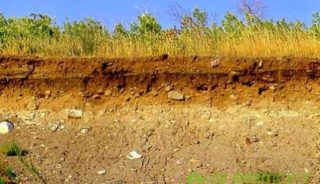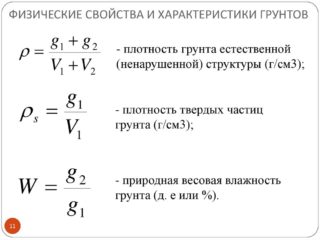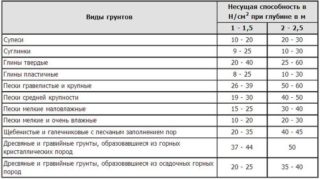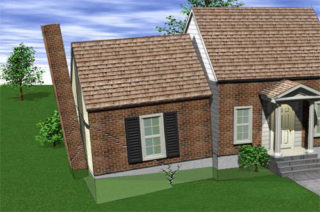The degree of soil susceptibility to loads is called the bearing capacity of the soil. The indicator characterizes the maximum average pressure between the base of the foundation and the ground, at which no shifts, landslides and dips occur in the surrounding layer. The value of the value is influenced by the type of soil, its physical and mechanical characteristics.
What is the bearing capacity of the soil and what does it affect

The concept is considered as the pressure perceived by a unit of area of the base, at which it does not deform and does not lead to the destruction of the structure. Geologists examine the soil to determine its properties and calculate the bearing characteristics.
The sensitivity of the soil to pressure depends on the conditions:
- type of soil;
- the massiveness of the layer;
- occurrence mark;
- indicators of the underlying formation;
- soil water level;
- the depth of freezing of the earth;
- rock density.
Indicators of the bearing capacity of wet and dry soil are different, because when saturated with moisture, the fluidity increases and the resistance to loads decreases. If the layer is in contact with liquid, it is classified as saturated. The exception is sandy coarse and medium-grained soils, which are not affected by deformation, since they allow moisture to pass through, and do not accumulate it.
Surveys are carried out to determine if the layer is suitable for installing the foundation or if it needs to be strengthened to increase the bearing capacity. Support elements are not designed at a depth where different layers border. The sole of the foundation is laid below the level of the soil moisture, since saturated rocks swell when freezing.
The sensitivity of the soil to loads is reduced by artificial compaction or the introduction of chemical modifiers. In the first case, piles are driven in to reduce the volume of voids in the soil. Chemical reagents promote adhesion (adhesion) of individual soil particles.
Determination of soil density and groundwater level
Density is found as the ratio of the weight of a soil sample at standard moisture content to the volume it occupies. The calculation is done according to the formula p = B / Vwhere:
- B - weight of soil in its natural state, g;
- V - volume, cm3.
Rocks that lie shallow from the surface are considered loose; with a decrease in the level, the soils become thicker, more reliable and stronger, since the overlying layers press on them. In Russia, sands and clays are observed, there are peatlands, marshlands and regions with rocky rocks.
Ground fluids are found in weak and loose rocks or cracks in tight formations. Soil moisture usually rises gradually and has no pressure.
The standing level depends on factors:
- precipitation, evaporation;
- air temperature, atmospheric pressure;
- changes in the state of water bodies;
- economic processes of human activity.
The moisture inside the layers can be aggressive, contain acids, alkalis, sulfates, carbon dioxide - such additives destroy concrete and metal foundations.Determine the liquid level by drilling in the field pits, which are torn off a few meters so that they are below the intended support level. The well is covered and left for 5 - 7 days. If no water is found in it, the soil does not contain moisture. In another case, to carry out construction work according to the rules, drainage (water drainage system) is needed.
How to determine the bearing capacity of the soil under the foundation yourself
The bearing capacity is found in a mathematical expression R = R0 (1 + K (B -100) / 100) (N + 200) / 2 200 - for deepening up to two meters, and the formula R = R0 (1 + K (B -100) / 100) + K2 Q (N - 200) - if the structure is submerged for more than two meters, where:
- R0 - counteraction to the load along the vertical axis, is contained in the tables and is determined by the type of soil;
- K2 - used for calculations in stable layers;
- K - the correction factor from the SP tables for the breed variety;
- B - transverse dimension of the bottom of the foundation;
- N - immersion depth of the support;
- Q - coefficient to find the calculated average specific gravity of the soil from the top of the earth to the bottom of the foundation.
The type of soil can be determined with your own hands. They take soil from the well at the immersion depth of the support, moisten it with water and roll the tourniquet, then it is connected into a ring. The element is without cracks, it is easily connected - the soil is cohesive, more often it is clay. When bending, cracks appear, which means that a mixture of clay and sand is in the hands, the latter contains 10 - 30%. The tourniquet is difficult to roll, and it is impossible to connect it in a ring - sandy soil.
Next, use the SNiP tables of the bearing capacity of the soil, where the required value can be found by the type of soil.
Risks of errors in the study of the bearing capacity of the soil
Incorrect determination of the bearing capacity of the soil entails troubles in the form of:
- erroneous calculation of the diameter of the pile, the area of the foot of the strip monolith, concrete slab;
- installation of support in loose soils, subsidence of the structure;
- incorrect choice of the deepening mark, pushing out the foundation by intumescent soils.
Many coefficients are used in the calculation, which must be accurately determined in the table, otherwise the foundation will be designed with errors that are easy to edit on paper, but difficult to eliminate after the walls and roof have been erected. The box of the house is loose, the floors are sagging as a result of excessive shrinkage after improperly installed piles. In the building there are cracks in the corners, window and door frames in the openings are warped, if the strip foundation moves.











